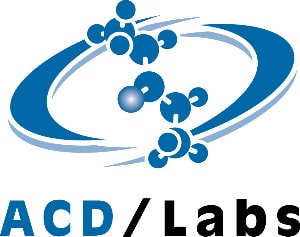Predicted properties
 Advanced Chemistry Development, Inc. (ACD/Labs) develops desktop and enterprise software solutions for chemical, biochemical, and pharmaceutical R&D. Our expertise lies in vendor-neutral spectroscopic data processing and prediction, physicochemical and ADMET property prediction, analytical knowledge management, interactive reporting, and integrating analytical data with chemical structures to help protect and leverage valuable research knowledge.
Advanced Chemistry Development, Inc. (ACD/Labs) develops desktop and enterprise software solutions for chemical, biochemical, and pharmaceutical R&D. Our expertise lies in vendor-neutral spectroscopic data processing and prediction, physicochemical and ADMET property prediction, analytical knowledge management, interactive reporting, and integrating analytical data with chemical structures to help protect and leverage valuable research knowledge.
Find definitions of properties predicted for ChemSpider using ACD/PhysChem Suite below.
The Partition Coefficient (LogP) is the equilibrium distribution of a solute between two liquid phases, the constant ratio of the solute's concentration in the upper phase to its concentration in the lower phase.
The Distribution Coefficient (LogD) is the ratio of the amounts of solute dissolved in two immiscible liquids at equilibrium. The distribution coefficient (logD) equation accounts for all possible partition coefficients (logP) that a system can obtain. For compounds containing a single ionizable group (acid/base) there are two partition coefficients or a single distribution coefficient accounting for the relative concentration of each species within each of the two possible phases.
The Boiling Point of a liquid is the temperature at which the liquid and vapor phases are in equilibrium with each other at a specified pressure. Therefore, the boiling point is the temperature at which the vapor pressure of the liquid is equal to the applied pressure on the liquid. The boiling point at a pressure of 1 atmosphere is called the normal boiling point.
The Flash Point is the lowest temperature at which the vapor of a combustible liquid can be made to ignite momentarily in air.
Vapor Pressure is the saturation pressure exerted by vapors which are in equilibrium with their liquid or solid forms. One of the most important physical properties of a liquid, it enters into many thermodynamic calculations and underlies several methods for the determination of the molecular weights of substances dissolved in liquids.
Polar Surface Area (PSA) is the measure of how much exposed polar area any two- or three-dimensional object has.
Freely Rotatable Bonds (FRB) exist between any single (sigma) bonded pairs of atoms. The FRB descriptor is a count of the number of single-bonds contained within a molecule. Some implementations of FRB also exclude additional bonds from the FRB count, so don't be surprised if you get three different results for FRB from three different vendors.
Hydrogen Bonds are an intermolecular attraction in which a hydrogen atom lies between two strongly electronegative atoms with lone pairs of electrons. Specifically Hydrogen Bonding is limited to the elements N, O, and F.
- Number of Hydrogen Bond Donors (NHBD) are the number N-H, O-H, and F-H fragments present in a compound
- Number of Hydrogen Bond Acceptors (NHBA) are the number of N, O, and F atoms with free lone pairs of electrons
Molecular Weight (MW) is the sum of the atomic weights of all the atoms in a molecule. Also called formula weight or molecular mass.
Parachor is the molecular weight of a liquid times the fourth root of its surface tension, divided by the difference between the density of the liquid and the density of the vapor in equilibrium with it; essentially constant over wide ranges of temperature.
Index of Refraction is the ratio of the speed of light in a vacuum to the speed of light in a medium under consideration. Also called refractive index.
Density is the mass per unit volume of a material. The term is applicable to mixtures and pure substances and to matter in the solid, liquid, gaseous, or plasma state. Density of all matter depends on temperature; the density of a mixture may depend on its composition, and the density of a gas on its pressure. Common units of density are grams per cubic centimeter, and slugs or pounds per cubic foot.
The Specific Gravity of a material is defined as the ratio of its density to the density of some standard material, such as water at a specified temperature, for example, 60°F (15.6°C), or, for gases, the basis may be air at standard temperature and pressure.
Surface Tension is a property of liquids arising from unbalanced molecular cohesive forces at or near the surface, as a result of which the surface tends to contract and has properties resembling those of a stretched elastic membrane.
Molar Volume is the volume occupied by one mole of a substance in the form of a solid, liquid, or gas. Also known as molal volume; mole volume.
Dielectric Constant of a solvent is a relative measure of its polarity.
Polarizability is the electric dipole moment induced in a system, such as an atom or molecule, by an electric field of unit strength.
Molar Refraction is the equation for the refractive index of a compound modified by the compound's molecular weight and density. Also known as the Lorentz-Lorenz molar refraction.